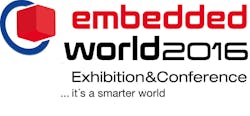Do you feel like you’ve been struggling to keep up with all the advances being made around the Industrial Internet of Things (IIoT) and associated technologies such as cloud computing and Big Data? If so, take heart; you're not alone. The technology suppliers themselves are in overdrive mode to modernize and adapt their existing technologies to these new trends while also creating new products to facilitate the transition into the Internet of Things (IoT) era.
Plenty of evidence to support this was on display at the Embedded World event in Nuremberg, Germany, February 23-25. Following is a brief rundown of a few of the new technology products, directions and vision I encountered at the event.
An interesting conceptual vision for industrial automation was on display at Innovasic’s stand in the Profinet booth, where I saw the idea for a new chip design to bring low-complexity Ethernet to sensor-level devices. Tom Weingartner and Volker Goller of Innovasic explained that the company has partnered with Analog Devices (a supplier of analog, mixed-signal and digital-signal processing integrated circuits) to develop this concept to put sensor-level data on Ethernet. Analog Devices’s technology provides the signal chain electronics for a sensor or an actuator so that Innovasic’s Ethernet technology can then be used to send/receive data—within in any Ethernet protocol—at the sensor/actuator level. OPC UA technology is used to visualize the data and interact with the devices.
Weingartner explained, “This Ethernet connection could eventually take place via two-wire Ethernet, thereby eliminating the need for gateways between Ethernet and 4-20mA devices.”
Through this low-complexity Ethernet design concept, “Innovasic has found a way to make Ethernet cost competitive with CAN,” noted Weingartner. He added that Innovasic plans to have a prototype for this new chip in place this summer with the final product developed by 2017.
At the Moxa exhibit, Stefan Palm explained the company’s vision for enabling connectivity for IIoT by providing “end–to-end devices needed for connecting industrial systems—from I/O to industrial PCs. Our background in connectivity and wireless access points gives us the insight to make IIoT a reality by providing the components to get data out of a system and have control over it.”
The newest offering on display from Moxa to manage the increasing amount of captured production data, as well as the devices used to deliver the data, was the ThingsPro Suite for distributed data acquisition and device management. Like Moxa’s ioLogik remote I/O device, the UC-8100-device used with ThingsPro also collects data from edge devices, but can conduct pre-processing of collected data for “higher levels of analysis and transmit data wired or wireless,” Palm said.
Built on an open Debian Linux platform, the ThingsPro Suite enables the integration of Modbus communications as well as device management, data acquisition and processing, and wireless networking.
Another forward-thinking concept on display—so new the company hasn’t yet published information about it on its website yet—was Intel’s Smart Link Technology. This is not to be confused with Intel’s Smart Connect Technology, which wakes PCs from sleep or standby mode to update applications. Smart Link Technology is a hardware and software stack designed to extend the use of legacy devices for IIoT applications.
According to Divya Mahesh, Intel’s development projects leader, Smart Link Technology comprises a hardware and software protocol adapter, functions as a security and management proxy for legacy devices, can perform light analytics data filtering and data transformation, and is customizable through a Java-based software development kit (SDK).
With legacy devices making up some 85 percent of the 50 billion devices currently installed by businesses globally, Intel’s goal is to prepare these devices for IoT use by enabling them to comply with security and privacy regulations, protect the intellectual property associated with them, create the ability to analyze their data, and centrally manage them, Mahesh said.
Mahesh noted that the Smart Link Technology SDK features a protocol bridge that provides building blocks to bridge legacy protocols. The SDK provides a “manageable endpoint and cryptographic identification for legacy devices and creates a secure tunnel between the device and the management console or the cloud,” she said.
As an industrial application reference point, Mahesh pointed out the Smart Link Technology could be used to connect legacy sensors on a piece of equipment to collect and monitor the data so that machine learning technologies and analytics could be applied to optimize maintenance for that equipment.
The Smart Link Technology development is so new that Intel is currently seeking industry partners to deploy and test the technology further. If you’re interested, contact Intel directly.
Leaders relevant to this article:


